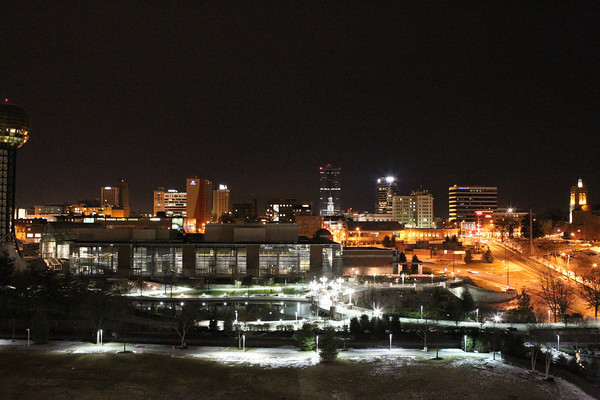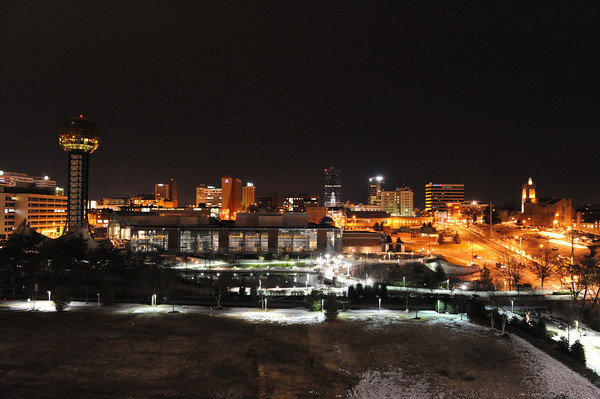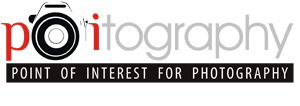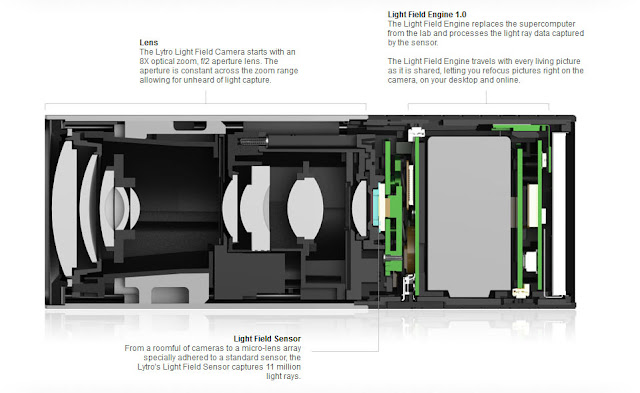Tuesday, June 5, 2012
New ways of taking photographs and feel by lytro
Competition in the world of photography has never stopped. Every company has a research division that determines the new innovation into the future of camera features. Innovation is not limited to professional cameras only. One is the magic Lytro camera, which frees us to choose the focus point even after the picture was taken.
The technology that brought Lytro is called light-field photography, where the camera works by collecting light from different directions and then processed by software on the camera as the 3D data of any kind to be photographed. This camera is only capable of producing approximately 1 megapixel images only.
Camera with the ability of these radicals are produced by a company from Silicon Valley and sells for USD 499 (about USD 4.5 million) for a model with a capacity of 16GB. As for the models with a capacity of 8GB priced USD 399 (about USD 3.6 million).
Lytro interface is very simple, it works the way the elaborate disguise. Control available is the power button and shutter, as well as a tiny strip to adjust the image magnification (zoom). Lytro also features a 1.5 inch touch screen that serves to target and control the exposure. Design Lytro so small and elegant, suitable for all levels of camera users. Although some of the complaints arose because the design is too small, that are found to be ergonomic.
Prepared, LSST Camera, Camera World's Largest

The world's largest digital camera, both physically and capacity, will be realized. Cameras that will be part of the Large Synoptic Survey Telescope (LSST) have now entered the design phase. This is the first step for the assembly will take two years.
This camera will take pictures of objects that exist beyond Earth. LSST will survey for three nights and took a picture which is equivalent to 800 000 with a capacity of eight-megapixel photos.
A total of 189 sensors and over 3 tons (2.7 tonnes) of components will be tightly packed into its cylindrical body. Work has already begun on the telescope’s 8.4-meter (27.5-foot) primary mirror, at the final site of the observatory on the Cerro Pachón ridge in northern Chile.
Plans for the LSST include studies on things such as dark energy and dark matter, detection of near-Earth asteroids, and analysis of the structure of the galaxy. Data will be available to anyone with internet access.
For three nights, the LSST will take as much as 30 terabytes of data every night. Camera capable of taking pictures with specs like that is a camera and weighs three tons and is capable of capturing an area 49 times the size of the Moon in a single frame. Wide and in this picture will catch every object that is close to the earth, from dark matter to dark energy.
DOE and the National Science Foundation who helped in the construction of this camera will be finished construction in 2014. Although still in the design phase, some small part started. Such as installation of a mirror of 8.4 meters and the construction of the telescope at Cerro Pachon homes, Northern Chile.

The LSST camera is designed to provide a wide field of view with better than 0.2 arcsecond sampling and spectral sampling in five or more bands from 400nm to 1060nm. The image surface is flat with a diameter of approximately 64 cm. The detector format will be a circular mosaic providing over 3 Gigapixels per image. The camera includes a filter mechanism and, if necessary, shuttering capability. The camera is positioned in the middle of the telescope. 1/2012 (Image credit: LSST Corporation)
Compare Nikon D3S vs Canon EOS-1D Mark IV
 |
| nikon-d3s-vs-canon-eos-1d-mark-4 |
Compare Nikon D3S vs Canon 1D Mark IV
Nikon vs Canon, when they launched the most advanced and latest digital SLR cameras. As usual, when one of the launching of new products, then another one soon followed. This time it launched the first Nikon D3 successor version with a video feature called D3S and was followed the next day with new products from Canon EOS 1D mark called IV. Both are big DSLR with an integrated vertical grip, sturdy material wrapped in a magnesium alloy body, and both are equipped with HD movie feature.
this time based on the results of tests conducted by the Rev. Digital TV. In the case of high speed between the Nikon D3s with Canon Eos 1D Mark IV almost has the same quality. Then the feature is also a bit similar, whereas it is clear in terms of different colors ... D3s characters tend to be stronger in color while the Eos 1D Mark IV has a soft color results.
Both cameras are aimed for professional photographers, sports and journalism. As a professional camera, both of which offer very high sensor sensitivity up to ISO 102400.
 |
| Canon_EOS_1Dmark IV iso_12800 |
 |
| Nikon D3S iso 12800 |
The Nikon has a 12-megapixel sensor and the Canon has a 16-megapixel sensor. Looks like the Canon is better, right? Not so fast. The Nikon’s larger, full frame sensor and lower resolution means it has bigger pixels – much bigger (8.45 microns compared to the Canon’s 5.7 micron pixels). Bigger pixels mean less noise and one of the main specs both camera makers are pushing is high ISO sensitivity. Nikon has published sample images at ISO 6400 and they look wonderful. Canon has yet to publish any 1D Mark IV sample images but with about 30% less surface area on each 1D pixel, they’ll be hard pressed to match the low noise of the D3S.
The new CMOS sensor on the Canon EOS 1D Mark IV is still using the standard APS-H. Standard sensors are only used on professional SLR digital cameras are Canon's own 1.3x crop factor. Therefore, the EOS 1D Mark IV is not included as a full frame camera.
Significant changes are also done on the autofocus system. Autofocus system on the EOS 1D Mark IV evolved into a 45-point AF sensor with 39-point AF sensor in which a cross type sensor. EOS 1D Mark III only uses 19-point cross-type AF sensor type. Cross-type sensors are not centered in the middle of the camera alone, but spread evenly across almost the entire surface of the camera sensor. Thus, the focus distance can be determined more accurately.
In terms of high sensitivity at high ISO, the EOS 1D Mark IV capabilities competing with Nikon D3s. Both have the highest sensitivity up to ISO 102,400. However, the images taken at ISO 102,400 is quite impressive. If both are compared, the characters that appear in the image noise at high ISO fairly close together. ISO 3200 for quality of images produced for the EOS 1D Mark IV and Nikon D3s, as well. When using the ISO 6400, Nikon a little lead. However, the performance is quite inappropriate given the positive appreciation.
In terms of color accuracy, the results from the EOS 1D Mark IV is taken with auto white balance mode under daylight type of light source of a slight deviation of 6.8 DeltaE. Accuracy is slightly below the Nikon D3s. In kualita images, Nikon D3s superior to the Canon 1D Mark IV, but the EOS 1D Mark IV has an effective resolution of 16.1 Megapixels. With higher resolution it is able to cover up a little short on the EOS 1D Mark IV held in picture quality. EOS 1D Mark IV can perform continuous shooting speed of 9.7 fps.
Compare Nikon D3S and Canon EOS-1D Mark IV Camera Specs
| Nikon D3S | Canon EOS-1D Mark IV | |
| Sensor type | Full frame CMOS | APS-H CMOS (1.3x crop factor) |
| Resolution | 12.1 megapixels (4256 x 2832) | 16.1 megapixels (4896 x 3264) |
| Pixel size | 8.45 microns | 5.7 microns |
| Sensitivity | ISO 200 to 12,800 – expandable to ISO 102,400 | ISO 100 to 12,800 – expandable to ISO 50 and 102,400 |
| Burst rate | 9 FPS (max resolution, RAW) | 10 FPS (max resolution, RAW) |
| Auto focus system | 51 points with 15 cross-type sensors | 45 points with 39 cross-type sensors |
| Flash sync | 1/250th second | 1/300th second |
| Exposure bracketing | 9 frames in 1/3, 1/2, 2/3 or 1 stop steps | 7 frames in 1/3 or 1/2, stop steps |
| Battery capacity | Approximately 4200 photos | Approximately 1500 photos |
Compare Nikon D3S and Canon EOS-1D Mark IV Video Specs
| Nikon D3S | Canon EOS-1D Mark IV | |
| Video resolution | 720p (1280 x 720) | 1080p (1920 x 1080) |
| Video frame rate | 24 FPS | 30, 24, 25 FPS at 1080p / 60 FPS at 720p |
| Video focus control | Single-shot contrast-detect auto focus with live touch-up AF | Single-shot contrast-detect auto focus (pre-focus) or manual focus |
| Video exposure control | Auto and aperture priority | Auto and full manual |
| Stereo sound | With optional external stereo mic | With optional external stereo mic |
| Video file format | .AVI | .MOV |
Some interesting things from Nikon D3S:
- FX format (full frame) but relatively low resolution of 12 MP alone (full frame DSLR other brands have reached level 24 MP) so noise can be reduced as low as possible and the highest ISO ISO 102.4000 is still appropriate.
- suitable for the pro who needs to capture high speed, thanks to a 51-point AF and 9 fps burst mode.
- capable of recording 24 fps HD movie, FX-sensitive sensor capable of recording video while the ambient light is very dim.
The main things that was introduced on the Canon EOS 1D Mark IV:
- APS-H format (1.3x crop factor) resolution of 16 MP
- 45 point AF with 39 cross-type manifold including
- dual Digic IV processor with 14 bit AD conversion
- 1080i HD movie recording with 24 or 30 fps
- very fast with a 10 fps burst mode
a comparison of the above can be concluded that they all - each brand has its advantages and disadvantages of - respectively. Nikon 3DS has the advantage in picture quality even though the ISO Noisenya little high, but lacking in quality HD VIDEOS, while the Canon EOS 1D Mark IV has a deficiency in the quality of the picture because it has plenty of noise in high ISO, while have a great quality in HD Video.
Subscribe to:
Posts
(
Atom
)


















